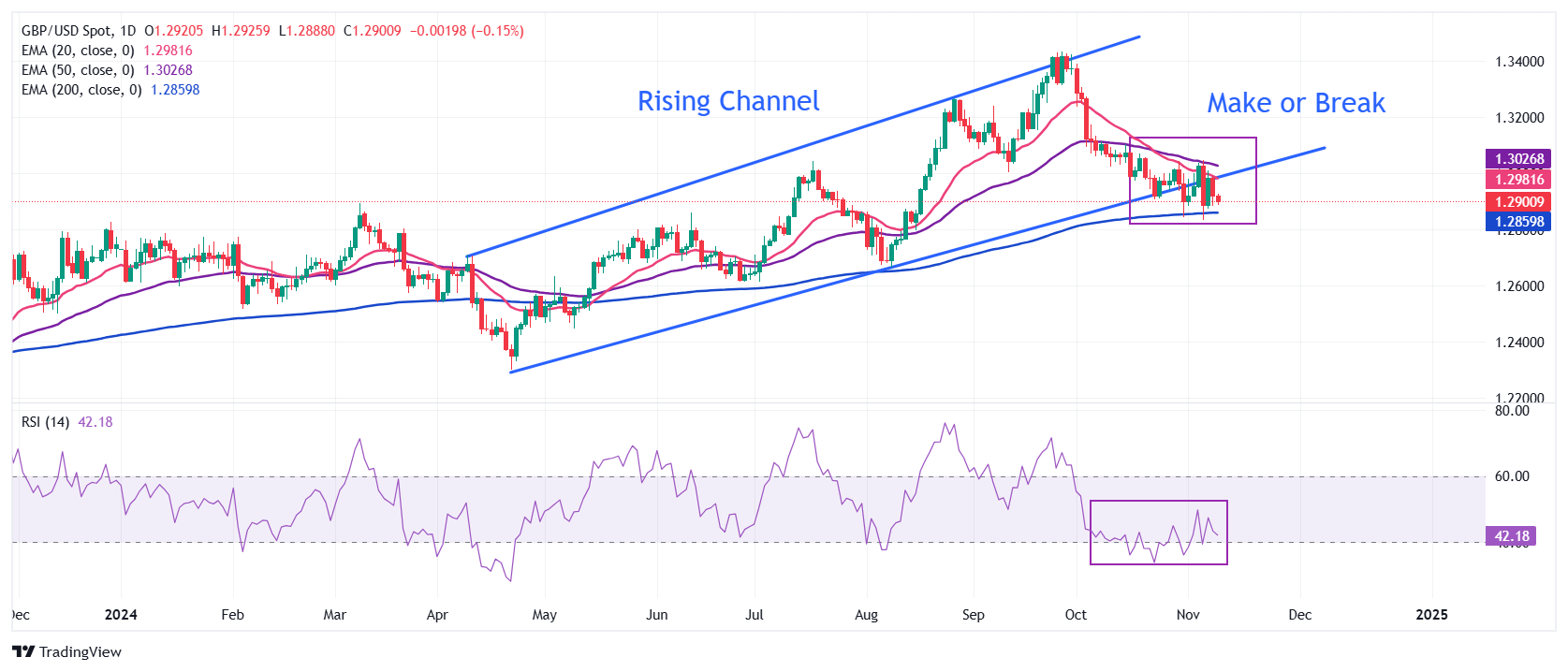- The Pound Sterling declines against US Dollar as investors await the UK Employment data for the three months ending September.
- The UK Unemployment Rate is estimated to have increased to 4.1%.
- The US Dollar will be influenced by the US inflation data for October.
The Pound Sterling (GBP) exhibits a mixed performance against its major peers on Monday, in a calm start of the week as investors keep their powder dry ahead of the United Kingdom (UK) labor market data for the three months ending September, which will be released on Tuesday. The jobs data could significantly influence market expectations for the Bank of England (BoE) monetary policy decision in the December meeting.
Economists expect that the Unemployment Rate rose to 4.1% in the three months to September from 4.0% in the quarter ending August. Investors will also pay close attention to the Average Earnings data, a key measure of wage growth that drives consumer spending. The growth in earnings has been a major contributor to high inflation in the services sector, which is closely tracked by BoE officials for decision-making on interest rates.
The Average Earnings Excluding bonuses are expected to have grown by 4.7%, slower than the former reading of 4.9%. Softer wage growth would lift expectations of more interest rate cuts by the BoE as it will suggest a further decline in inflation in the service sector. On the contrary, higher wage growth would do the opposite. Average Earnings including bonuses are estimated to have accelerated to 3.9% from the prior release of 3.8%.
Last week, the BoE reduced its interest rates by 25 basis points (bps) to 4.75%, as expected. BoE Governor Andrew Bailey signaled a more gradual policy-easing approach and emphasized that the bank is committed to bringing inflation down sustainably to the desired rate of 2%.
British Pound PRICE Today
The table below shows the percentage change of British Pound (GBP) against listed major currencies today. British Pound was the strongest against the Japanese Yen.
| USD | EUR | GBP | JPY | CAD | AUD | NZD | CHF | |
|---|---|---|---|---|---|---|---|---|
| USD | 0.59% | 0.37% | 0.65% | 0.30% | 0.10% | -0.01% | 0.43% | |
| EUR | -0.59% | -0.26% | 0.13% | -0.19% | -0.40% | -0.51% | -0.08% | |
| GBP | -0.37% | 0.26% | 0.30% | 0.06% | -0.14% | -0.26% | 0.14% | |
| JPY | -0.65% | -0.13% | -0.30% | -0.33% | -0.62% | -0.55% | -0.23% | |
| CAD | -0.30% | 0.19% | -0.06% | 0.33% | -0.15% | -0.32% | 0.08% | |
| AUD | -0.10% | 0.40% | 0.14% | 0.62% | 0.15% | -0.13% | 0.29% | |
| NZD | 0.01% | 0.51% | 0.26% | 0.55% | 0.32% | 0.13% | 0.41% | |
| CHF | -0.43% | 0.08% | -0.14% | 0.23% | -0.08% | -0.29% | -0.41% |
The heat map shows percentage changes of major currencies against each other. The base currency is picked from the left column, while the quote currency is picked from the top row. For example, if you pick the British Pound from the left column and move along the horizontal line to the US Dollar, the percentage change displayed in the box will represent GBP (base)/USD (quote).
Daily digest market movers: Pound Sterling weakens against US Dollar
- The Pound Sterling drops to near 1.2900 against the US Dollar (USD) in North American trading hours on Monday. The GBP/USD pair declines as the US Dollar extends Friday’s recovery and aims to revisit a four-month high. The US Dollar Index (DXY), which gauges Greenback’s value against six major currencies, climbs above 105.30.
- The Greenback strengthens on expectations of higher investment and spending in the United States (US) as Republicans look set to take control of both the Senate and the House of Representatives, a scenario that would allow the Trump administration to implement fiscal policies quickly.
- The expected change in government policies, from higher import tariffs to lower taxes, would boost the US fiscal deficit and inflationary pressures, a scenario that could force the Federal Reserve (Fed) to opt for a restrictive policy stance. However, Fed Chair Jerome Powell pushed back expectations of any near-term impact on the monetary policy last Thursday after the central bank cut interest rates by 25 basis points (bps) to 4.50%-4.75%.
- This week, a slew of Fed officials are lined up for commentary on Thursday’s interest rate decision and guidance for monetary policy action in the last meeting of this year in December. In addition to Fed speeches, investors will also focus on the US Consumer Price Index (CPI) data for October, which will be published on Wednesday. The CPI report is expected to show that the annual headline inflation accelerated to 2.6% from 2.4% in September, with core figures growing steadily by 3.3%.
Technical Analysis: Pound Sterling slides below 1.2800
The Pound Sterling trades at a make or a break against the US Dollar near the breakdown region of the rising channel pattern. The near-term trend of GBP/USD remains bearish as the 20-day and 50-day Exponential Moving Average (EMAs) around 1.3000 and 1.3035, respectively, are declining. However, the pair remains well-supported by the 200-day Exponential Moving Average (EMA) around 1.2860.
The 14-day Relative Strength Index (RSI) hovers near 40.00. A bearish momentum would resume if the RSI (14) fails to hold above this level.
Looking down, the August low at 1.2665 will be a major cushion for Pound Sterling bulls. On the upside, the Cable will face resistance near the psychological figure of 1.3000.
Employment FAQs
Labor market conditions are a key element to assess the health of an economy and thus a key driver for currency valuation. High employment, or low unemployment, has positive implications for consumer spending and thus economic growth, boosting the value of the local currency. Moreover, a very tight labor market – a situation in which there is a shortage of workers to fill open positions – can also have implications on inflation levels and thus monetary policy as low labor supply and high demand leads to higher wages.
The pace at which salaries are growing in an economy is key for policymakers. High wage growth means that households have more money to spend, usually leading to price increases in consumer goods. In contrast to more volatile sources of inflation such as energy prices, wage growth is seen as a key component of underlying and persisting inflation as salary increases are unlikely to be undone. Central banks around the world pay close attention to wage growth data when deciding on monetary policy.
The weight that each central bank assigns to labor market conditions depends on its objectives. Some central banks explicitly have mandates related to the labor market beyond controlling inflation levels. The US Federal Reserve (Fed), for example, has the dual mandate of promoting maximum employment and stable prices. Meanwhile, the European Central Bank’s (ECB) sole mandate is to keep inflation under control. Still, and despite whatever mandates they have, labor market conditions are an important factor for policymakers given its significance as a gauge of the health of the economy and their direct relationship to inflation.
Information on these pages contains forward-looking statements that involve risks and uncertainties. Markets and instruments profiled on this page are for informational purposes only and should not in any way come across as a recommendation to buy or sell in these assets. You should do your own thorough research before making any investment decisions. FXStreet does not in any way guarantee that this information is free from mistakes, errors, or material misstatements. It also does not guarantee that this information is of a timely nature. Investing in Open Markets involves a great deal of risk, including the loss of all or a portion of your investment, as well as emotional distress. All risks, losses and costs associated with investing, including total loss of principal, are your responsibility. The views and opinions expressed in this article are those of the authors and do not necessarily reflect the official policy or position of FXStreet nor its advertisers. The author will not be held responsible for information that is found at the end of links posted on this page.
If not otherwise explicitly mentioned in the body of the article, at the time of writing, the author has no position in any stock mentioned in this article and no business relationship with any company mentioned. The author has not received compensation for writing this article, other than from FXStreet.
FXStreet and the author do not provide personalized recommendations. The author makes no representations as to the accuracy, completeness, or suitability of this information. FXStreet and the author will not be liable for any errors, omissions or any losses, injuries or damages arising from this information and its display or use. Errors and omissions excepted.
The author and FXStreet are not registered investment advisors and nothing in this article is intended to be investment advice.
Recommended content
Editors’ Picks

GBP/USD price hovers around 1.2950 near nine-day EMA
The GBP/USD pair holds steady after gains in the previous session, hovering around 1.2950 during Friday's Asian trading hours. The technical analysis of the daily chart suggests a sustained bullish outlook, with the pair consolidating within an ascending channel pattern.

Gold price retains bullish bias near record high as trade tensions boosts safe-haven demand
Gold price continues to attract safe-haven flows amid rising trade tensions. Fed rate cut bets keep the USD bulls on the defensive and also lend support. Traders now look to the US PCE Price Index for some meaningful impetus.

EUR/USD trades with mild negative bias below 1.0800; focus remains on US PCE
The EUR/USD pair struggles to capitalize on the previous day's goodish bounce from over a three-week low, around the 1.0730 area, and edges lower during the Asian session on Friday. Spot prices currently trade with mild negative bias below the 1.0800 mark.

Bitcoin stabilizes while Ethereum and Ripple show weakness
Bitcoin price stabilizes at around $87,000 on Friday, as its RSI indicates indecisiveness among traders. However, Ethereum and Ripple show signs of weakness as they face resistance around their key levels and face a pullback this week.

US: Trump's 'Liberation day' – What to expect?
Trump has so far enacted tariff changes that have lifted the trade-weighted average tariff rate on all US imports by around 5.5-6.0%-points. While re-rerouting of trade will decrease the effectiveness of tariffs over time, the current level is already close to the highest since the second world war.

The Best brokers to trade EUR/USD
SPONSORED Discover the top brokers for trading EUR/USD in 2025. Our list features brokers with competitive spreads, fast execution, and powerful platforms. Whether you're a beginner or an expert, find the right partner to navigate the dynamic Forex market.
